Some popular enterprise SEO tools include:
| Product | Reviews | Pricing | Customers |
|---|---|---|---|
| Ahrefs | Starts at $14,990 / year | 60,000+ | |
| Conductor |
| No public pricing | 450+ |
| seoClarity | 3,500+ | ||
| Botify |
| No public pricing | 500+ |
| BrightEdge | No public pricing | 1,700+ |
With so many different tools and so many different needs, how do you know what’s right for you?
I’m obviously biased towards Ahrefs, but we’re really in a league of our own with 44% of the S&P 500 choosing us. Look how we compare to other enterprise SEO tools in the market.
And our organic search share of voice (SoV).

Website Organic Search Traffic - 8.1M
Website Organic Traffic Value - $3.6M
Brand Searches - 464K
Backlinks - 37.5M
Referring Domains - 80.2K

This is obviously my top pick, but it deserves to be. Don’t just take my word for it. Ask around and see who comes up as the platform of choice for SEOs. See who real users favor.
How Ahrefs describes themselves:
Ahrefs is an all-in-one SEO toolset for growing search traffic and optimizing websites.
We crawl the entire web, collect and process petabytes of data every day, then give this information context and make it accessible via a simple user interface.
Our crawler processes up to 8 billion pages a day, and we update our index with the freshest backlinks on the web every few minutes.
I’m biased because I work here, but I work here because I’m a fan and I strongly believe in the product, the data, and the company.
Unique selling proposition of Ahrefs: Data. We have better data than anyone else, over 715 PBs of data, and we know how to use it. More keywords, faster discovery of keywords, more links, faster discovery of links.
Ahrefs features:
- Keyword research
- Backlink analysis
- Rank tracking
- Link building
- Competitor analysis
- Site audits
- SEO alerting
- SEO change tracking
- Content creation
- and many more.
Pros of Ahrefs according to Reddit users:
- Comprehensive SEO Tools: Ahrefs is known for its wide range of SEO tools, including keyword research, backlink analysis, site auditing, and more, making it a one-stop solution for many SEO needs.
- Accurate Data: Users have praised Ahrefs for its accurate and up-to-date data, particularly in terms of backlinks and keyword rankings.
- Competitor Analysis: Ahrefs offers robust competitor analysis tools, allowing users to gain insights into their competitors’ strategies and performance.
- User-Friendly Interface: Many users find Ahrefs’ interface intuitive and user-friendly, which can be particularly helpful for those new to SEO.
- Regular Updates and Improvements: Ahrefs is known for continuous updates and improvements to its tools and features, staying relevant in the ever-evolving field of SEO.
- Customer Support: Users have reported positive experiences with Ahrefs’ customer support, noting quick response times and helpful assistance.
Cons of Ahrefs according to Reddit users:
- Limited Local SEO Data: Ahrefs’ local SEO capabilities, while present, may not be as robust as some other specialized local SEO tools.
- No phone support: Ahrefs does not offer phone support.
Ahrefs has over 60,000 subscribers including many of the world’s top enterprise companies like:
- Adobe
- eBay
- IBM
- Zoom
- Johnson & Johnson
- Dell
- Capital One
- Accenture
- Tripadvisor
- Hubspot
- SurveyMonkey
- Shopify
- Expedia
Be sure to watch our how to use Ahrefs videos!
Why Ahrefs is the right choice
We’re the favorite tool for enterprise SEO teams. We epitomize big data.
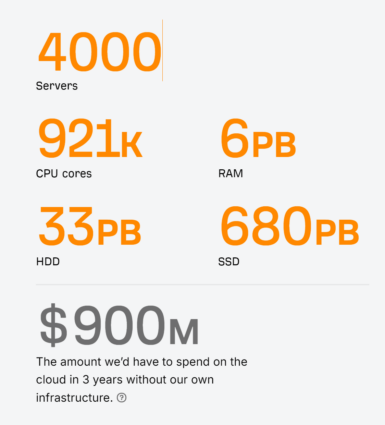
For some context, Google’s index is around 100 PB. We store over 7x that amount.
You’ll see these differences between us and competitors in the platform itself. We’re extremely fast and have granular data that no one else has.
We also have the 34th fastest supercomputer in the world! This lets us do more with machine learning and AI than most companies on the planet.

We crawl faster than any other SEO tool, according to Cloudflare Radar.

We’re the best backlink checker, according to Matthew Woodward’s test of 1 million domains. We’re the only SEO tool that will pick up links added with JavaScript for our backlink index because we’re the only one that renders pages while crawling the web.
On top of that, we’re the only SEO platform that is fed data from IndexNow which is a data submission partnership used by search engines. 60 million sites are feeding us 2.5 billion new and updated pages per day.
For links and pages, that means we have the largest and freshest data.
We have the largest keyword database with 110B keywords that we filter to remove noise, because we also care about the quality of data shown to users. Our filtered dataset is larger than most competitors entire data sets!
We have the most accurate traffic estimates, according to Authority Hacker. For keywords where we have enough data, we use individually model click-through rate (CTR) curves rather than using a single generic model for the curves.
We’re constantly adding to the product. We made 130+ product updates in 2023. You can find many of our upcoming product updates on our pricing page, including an always-on version of Site Audit, some forecasting options, the ability to import historical data for keywords in Rank Tracker, a cutting edge content tool, some more reporting capabilities, and a system called Patches that will solve SEO issues at scale.
There are also our industry-leading articles, videos, and courses. These resources will educate you on SEO and show you how to make the best use of the platform.
Ahrefs features built for enterprise SEO
We have a lot of features that enterprise SEOs love.
Opportunities reports
Knowing what to prioritize is the hardest part of SEO. We created the Opportunities report to help SEOs work on things that will move the needle. If you’re not sure where to start, look at these reports and measure progress towards the opportunities shown and you will likely show a lot of success to your stakeholders. This report is a great starting point for an enterprise SEO audit.
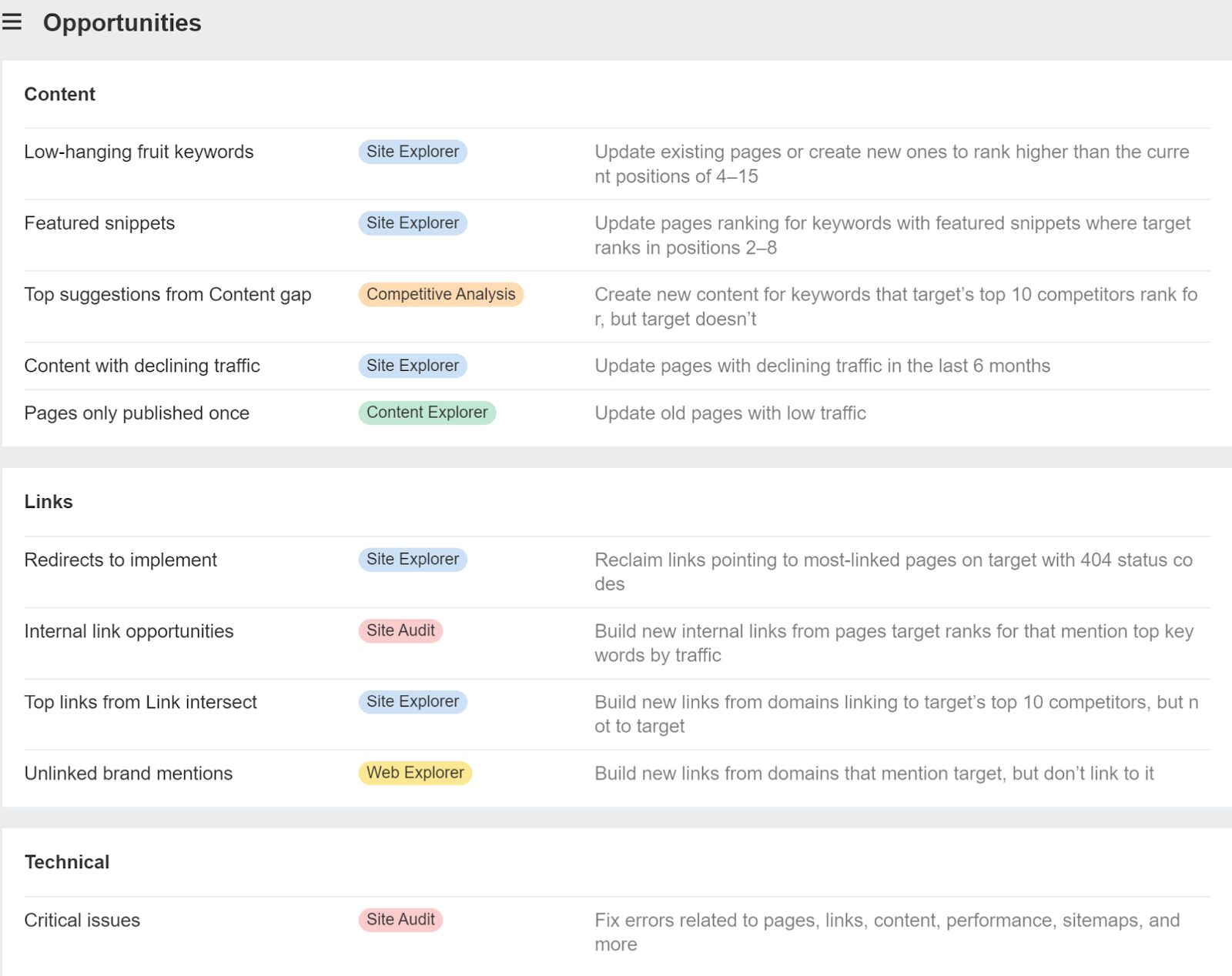
You could also work with the in-house team or the dev team if you are in-house to create a visualization of what you consider the most important and impactful SEO projects. I normally use an impact / effort matrix for this to show how hard projects are and their estimated impact. Based on their coordinates, it’s easy to see which projects you should prioritize.
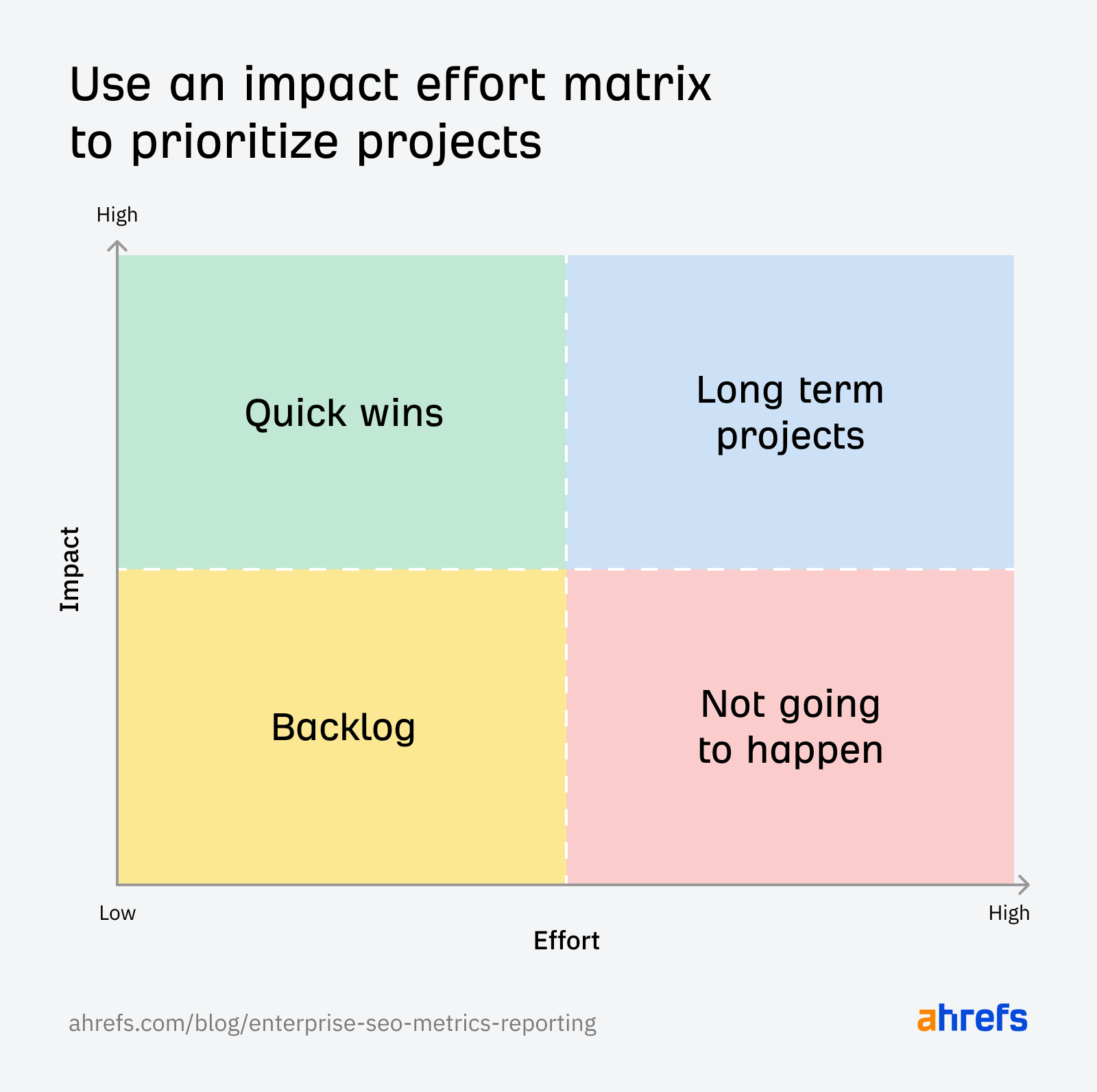
Market views
For a high-level overview of the competitor landscape that is visually appealing, check out the Organic Competitors report in Ahrefs’ Site Explorer. This shows you three different metrics at a glance including Organic Traffic Value, Organic Traffic, and the number of pages on the site. You can also use a list of custom sites for the visualization if there are certain competitors you want to show.
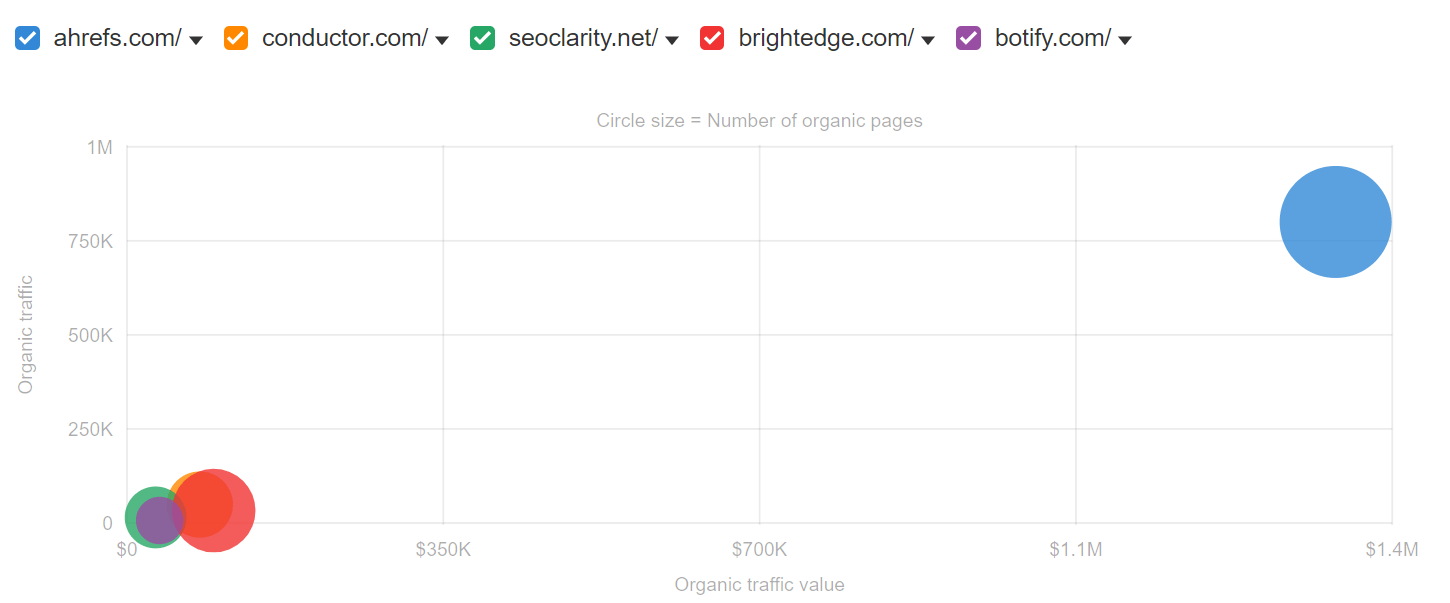
You can add a date comparison such as this year vs. last year to show how the market has evolved over a period of time.

The report will also work with more than just domains. You can plug in a specific website path or page if you’re reporting to a particular group or product team and need a more narrow view. We also have charts for Share of Voice (SoV) & Share of Traffic Value (SoTV). SoTV is unique to Ahrefs. It’s more of a money metric, tied to the paid search cost of organic traffic. 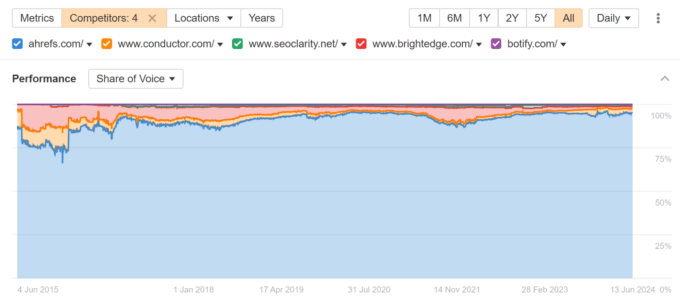
Portfolios
Now, you can group a list of up to 1000 URLs from up to 10 unique domains and track them as a single project to see their aggregated metrics in Site Explorer. If you want to segment a site, or track multiple sites and research as if they were one, you can. You can use it to:
- Track your top competitors as a single entity to gain insight into how your industry is doing as a whole in terms of search traffic, how it’s coping with major Google algorithm updates, how it compares to other industries, and so on.
- Combine multiple “regional” domains to track their performance as a single entity.
- Create author-specific portfolios if you have multiple authors publishing content on your website. This lets you see which authors are bringing the most search traffic and backlinks, which ones have a higher publishing pace, and so on.
- Set up client portfolios to create focused reports showing how your portfolio of content on their website has been performing.
- Create sets of pages for testing on-page SEO tactics. Just set up a portfolio of the pages you’re implementing these tactics on, and track it against a second portfolio of pages in your control group.
- Do rank tracking on steroids – no need to manually track hundreds of keywords per page when you can create a portfolio of pages, and be shown the thousands of keywords that they rank for.
Enterprise SEO scorecards
SEO scorecards let you monitor performance and compare one group to another or one section of a site to another.
Our Site Structure report in Site Explorer has a lot of the information you’d use to create this scorecard view. You can even compare between two dates.
The columns are customizable so you can show only the metrics you need. We have Referring Pages, Referring Domains, Organic Traffic, Traffic Value, Organic Keywords, and Organic Pages available.
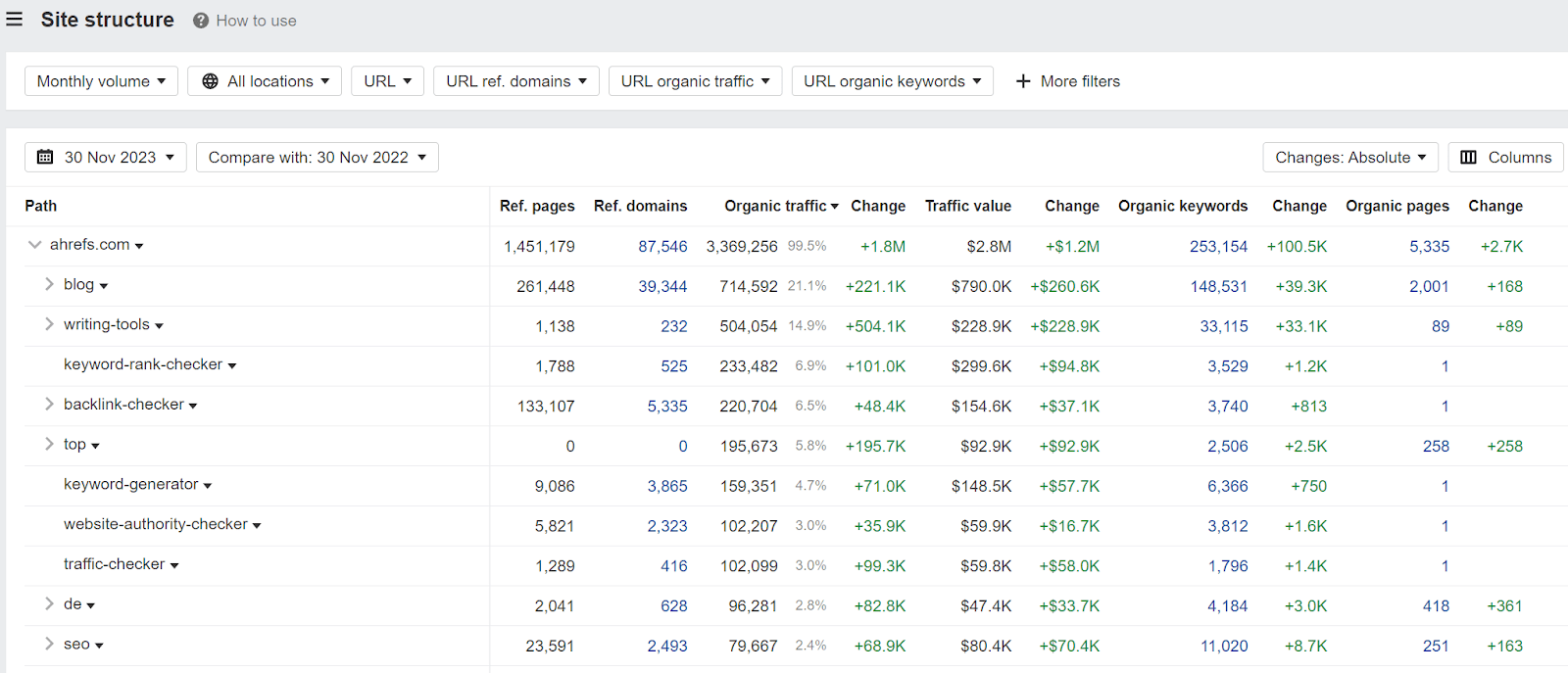
You can pull technical issues from Site Audit where you might want to show health scores over time for different sections of the site, Core Web Vitals, or general errors. In the past, I’ve created views that showed the number of pages we still need to redirect, Core Web Vitals scoring, and pages that have too many redirect hops.

You can also create custom groupings of pages using our Portfolios feature. If you have a business unit or product offering that owns some pages on the blog, some pages in the product section, some pages in support, etc., then you can add them as a Portfolio to get a rolled up view. Portfolios support up to 10 different domains and 1,000 different pages or paths.
Your GSC data, but better
With the GSC Overview report, your team can analyze your Google Search Console property and see the distribution of clicks, impressions, and CTR by position right in Rank Tracker. We store the full history, from the time you connect the data.

If you’re doing opportunity forecasting to sell content creation initiatives, you’ll find our custom CTR curve models handy. They’re based on your own Google Search Console (GSC) data.
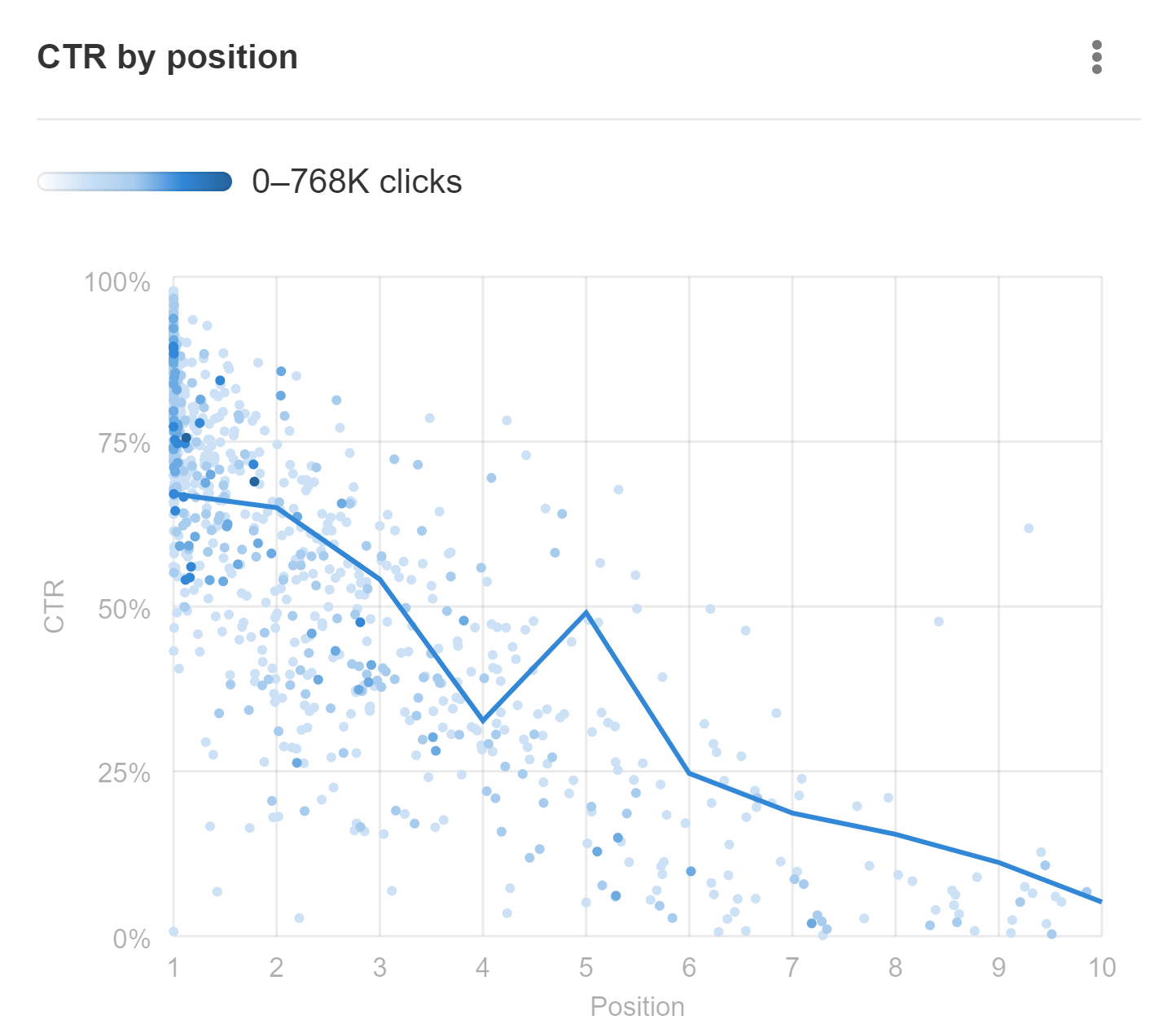
We also have
- Top keywords
- Top keyword changes
- Low hanging fruit keywords, which shows you the most popular keywords where your target’s ranking position is between 4 and 15
- Potential cannibalization, which shows you keywords with multiple ranking URLs
- Top pages
- Top page changes

Content opportunities
You can use the Content Gap tool to find these opportunities, but you may see some repeated opportunities because of similar keywords. We will update this to add clustering and help reduce this extra noise.

For now, you may want to export the keywords from the Content Gap tool and paste them into Keywords Explorer. Then go to the “Clusters by Parent Topic” tab. This should give you actual content opportunities you may not be covering.
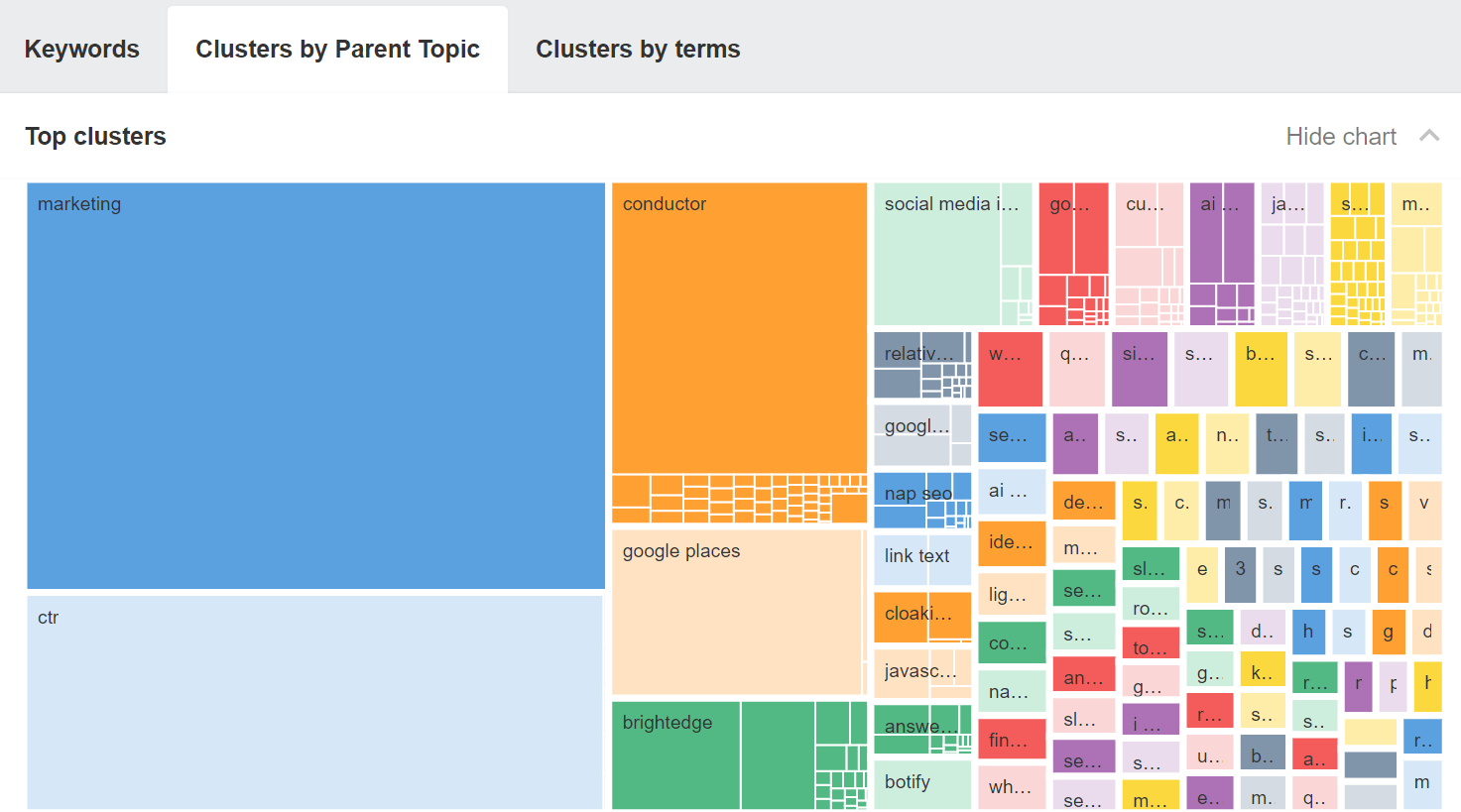
You can take these opportunities and the total volume of the clusters to use in your forecasts to come up with more accurate forecasts than those that use just one term per page. You could also just look at our Traffic Potential (TP) metric to get an idea of how much traffic a page might get.
AI Content Grader tool
Just enter your URL and its target keyword, and Content Grader will:
- Take the top 3 articles ranking for that keyword and identify the core topics covered in those articles
- Analyze how well your article and the top articles cover each topic
- Identify the topics that your article has lower scores for
- Show suggestions on how to improve your content to get better results
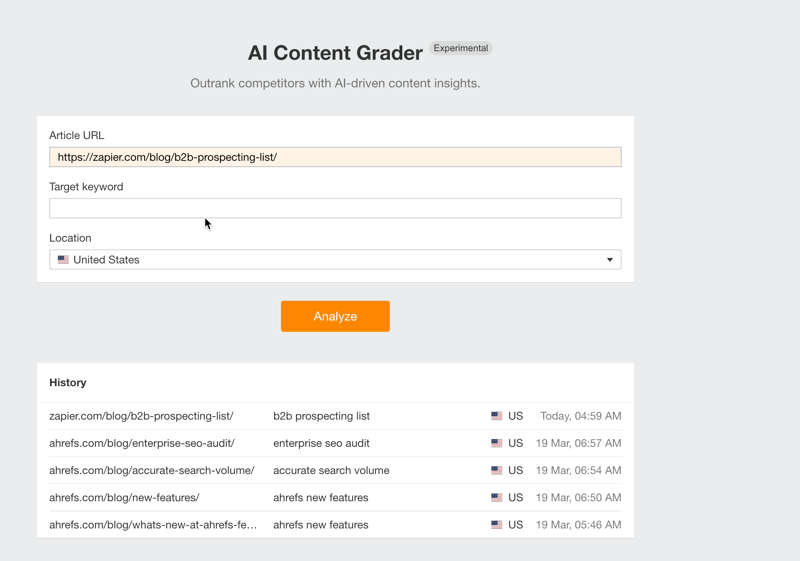
Find internal link opportunities
Our Internal link opportunities report identifies internal link opportunities by taking the top 10 keywords for your ranking pages—then finding mentions of them on your other pages. Including important keyword metrics and the keyword context. How cool is that?

Search intent
You can use the “Identify intents” feature in Keywords Explorer to show the main intent of each term and the percentage of traffic to each intent. This helps you identify content angles or ways you can position your content to maximize traffic or if you’re even targeting the right things.
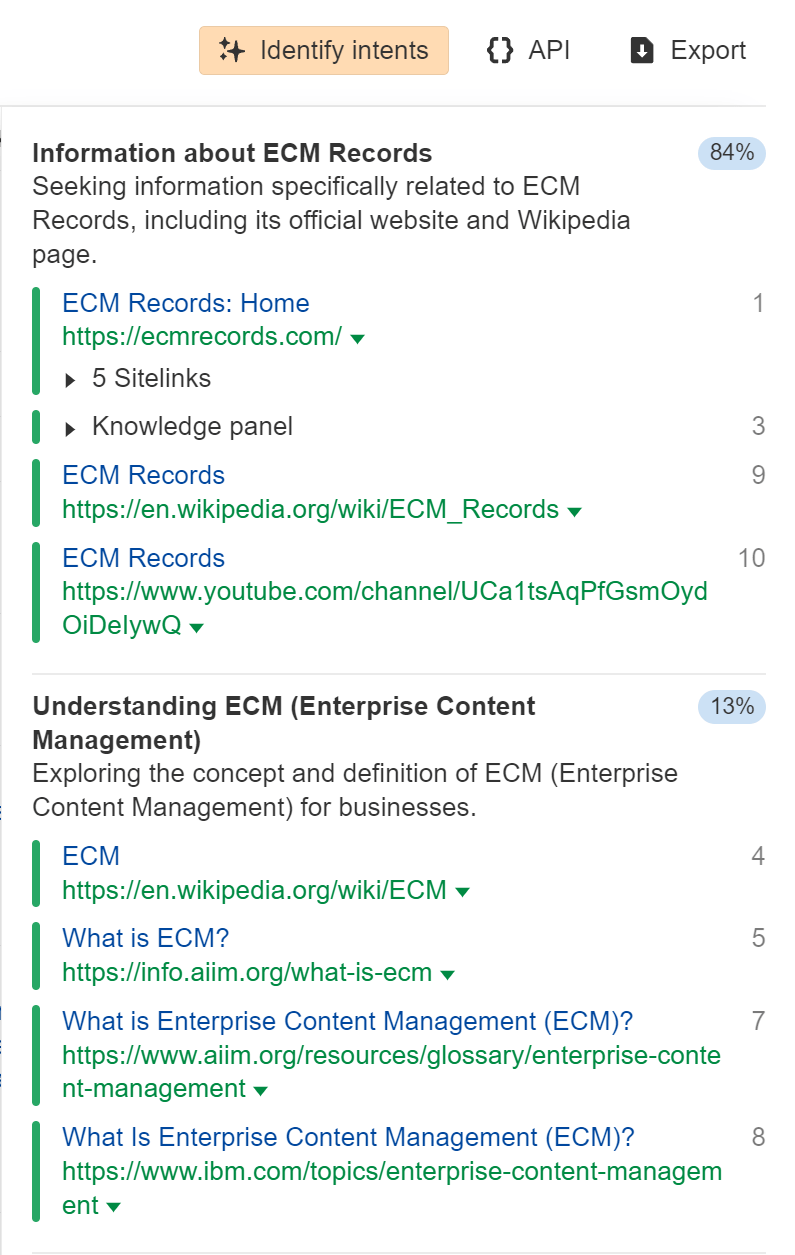
Granular keyword data
On the Overview report in Keywords Explorer, you’ll find things like the distribution of paid/organic, mobile/desktop split, the distribution across search type like web, image, video, or news. These help you understand the format searchers prefer.

Competition monitoring
You can add competitors on the dashboard to keep an eye on their overall stats and how you compare. This is useful for creating competitor scorecards.

You can use Content Explorer to keep an eye on your competitors’ newly-published pages and pages that they have updated.
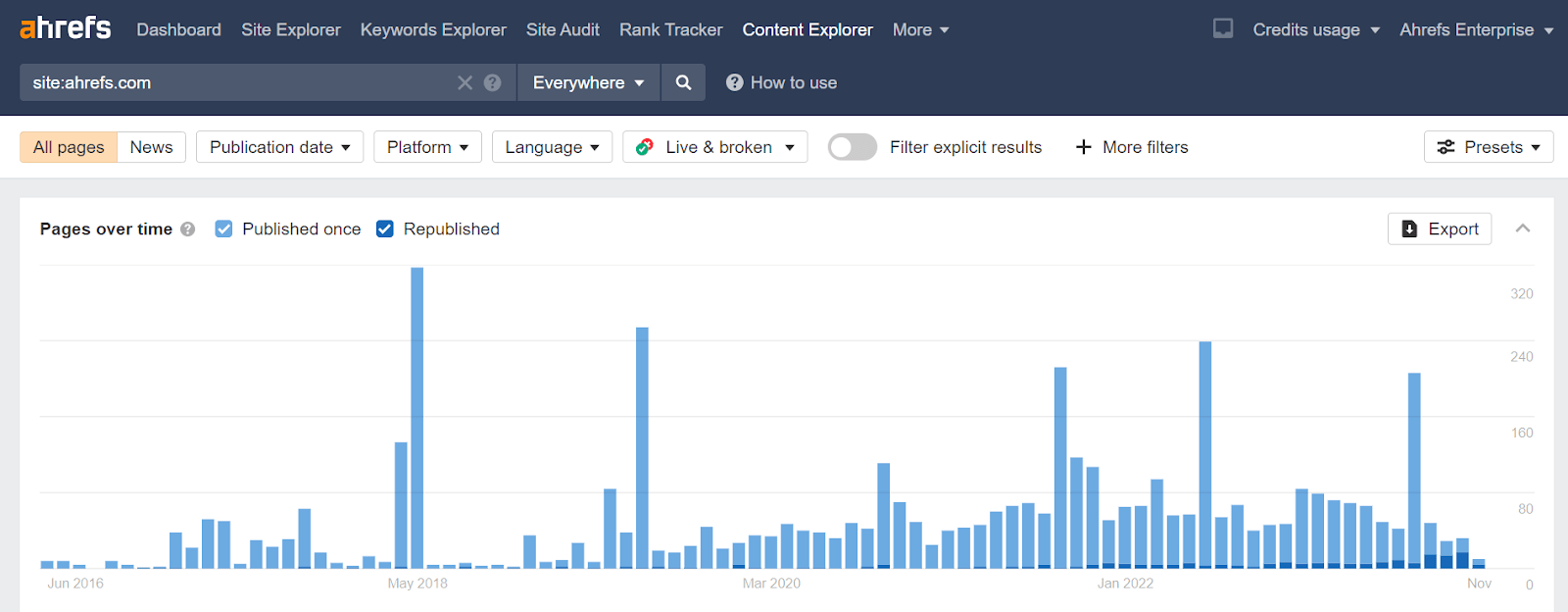
If you create a Portfolio on the Dashboard that includes competing websites, you end up with some pretty interesting views in other reports. For instance, you can get winners and losers for pages and keywords across all of your monitored competitors.

You can also see new and lost pages and keywords to see what is working well for your competitors and what they’re getting rid of.
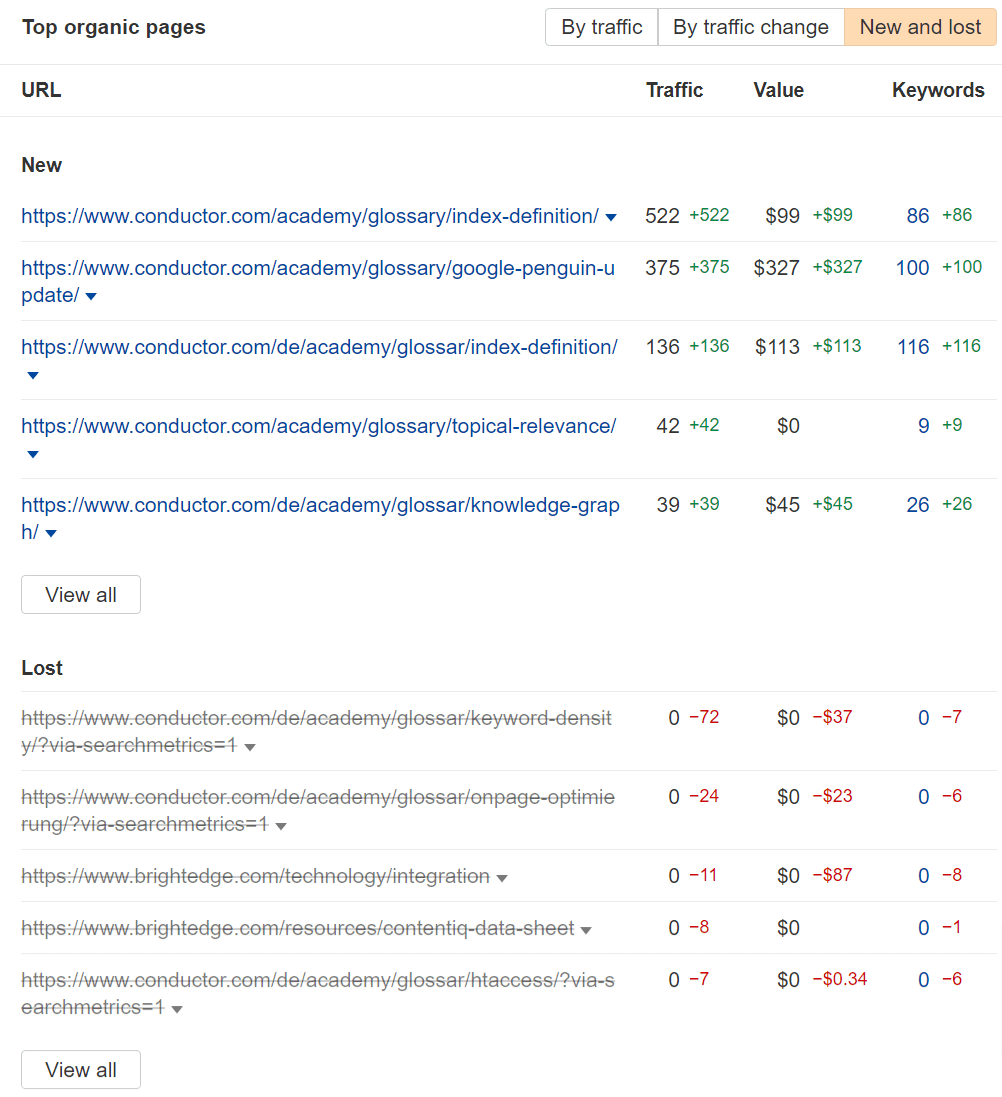
Page inspect shows you the history of page changes over time. The darker the color, the more content changes were made on a page that day.
For example, this square on Jan 8 is a deep green. Clicking it shows you the exact things that have changed on this page – in this case, a huge content update.

YoY trends
You can also look at YoY trends for your own site. You may want to use your GSC or analytics data if you have it, but GSC is typically limited to 16 months of data. If you’ve connected it to Ahrefs though, we store and show a longer period of time and you’ll eventually be able to show the YoY data for this for multiple years.
You can also use the Years tab in Overview along with average volume to show general trends or issues. We show trends for Organic Traffic Value, Organic Traffic, Referring Domains, Domain Rating, URL Rating, Organic Pages, and Crawled pages.
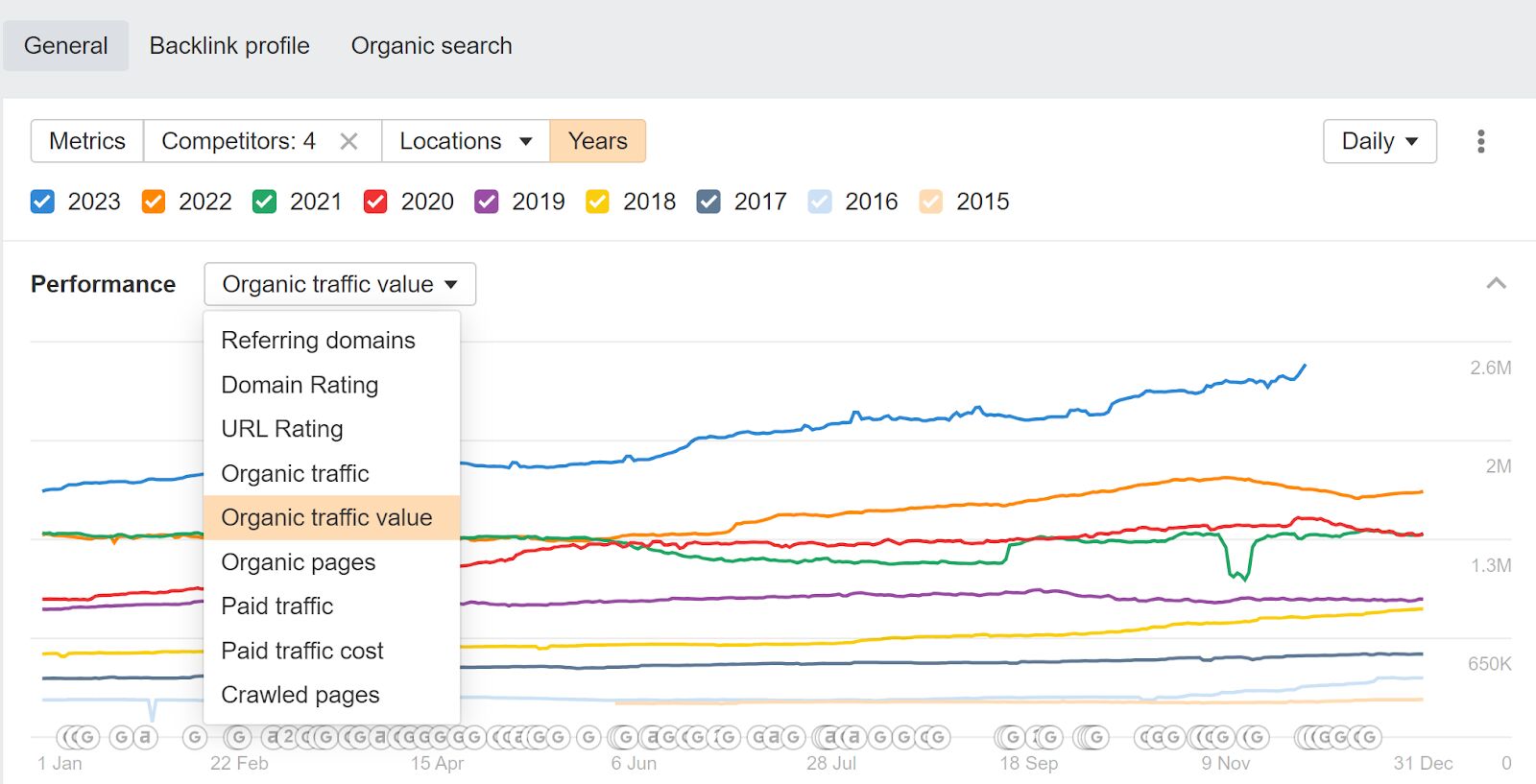
Critical page and keyword monitoring
Enterprise companies will typically have some kind of top pages or top keywords project. These look at the most critical pages and/or keywords for your business and help you see their performance over time and any trends or issues.
They’re typically used in meetings where there is a quick analysis and an action plan created for any issues or for any successes. You try to look at what worked well so you can replicate it, and try to look for any issues to see what happened.
You can use the Compare pages tab in the Top Pages report in Site Explorer to get this kind of view for your pages. We will be adding one for the Organic Keywords report in the future as well.
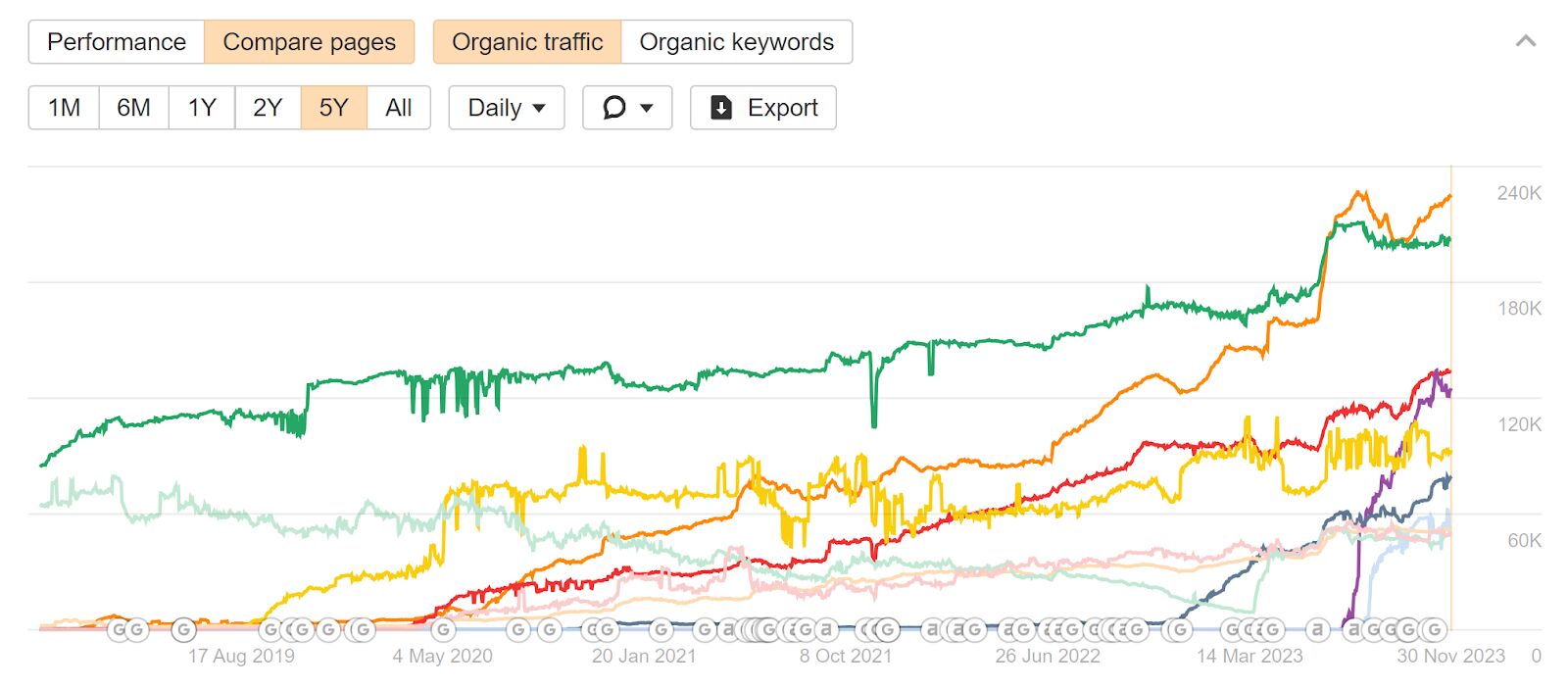
Crawl comparisons
Select any two crawls for comparison.
For example, you can compare a recent crawl for your website to a crawl back in, say, January. Click on the organic traffic changes column to sort your results and quickly find pages with significant traffic drops during this time.

Or, go to All issues to track how you’ve been dealing with technical issues on your site since then.

Track Rankings
Rank Tracker allows for custom segmentation via a flexible tagging system. You can have branded and unbranded, specific product or business unit tags, authors, top 20, or any number of groupings for your own use cases. There are a number of different things you can track, but lots of people typically want to see rankings.
![]()
Winners & losers for pages and keywords
You’ll want to check your own pages and keywords to see what’s working well and what’s not. You can do this on the Dashboard or with filters on the individual reports to see more data.
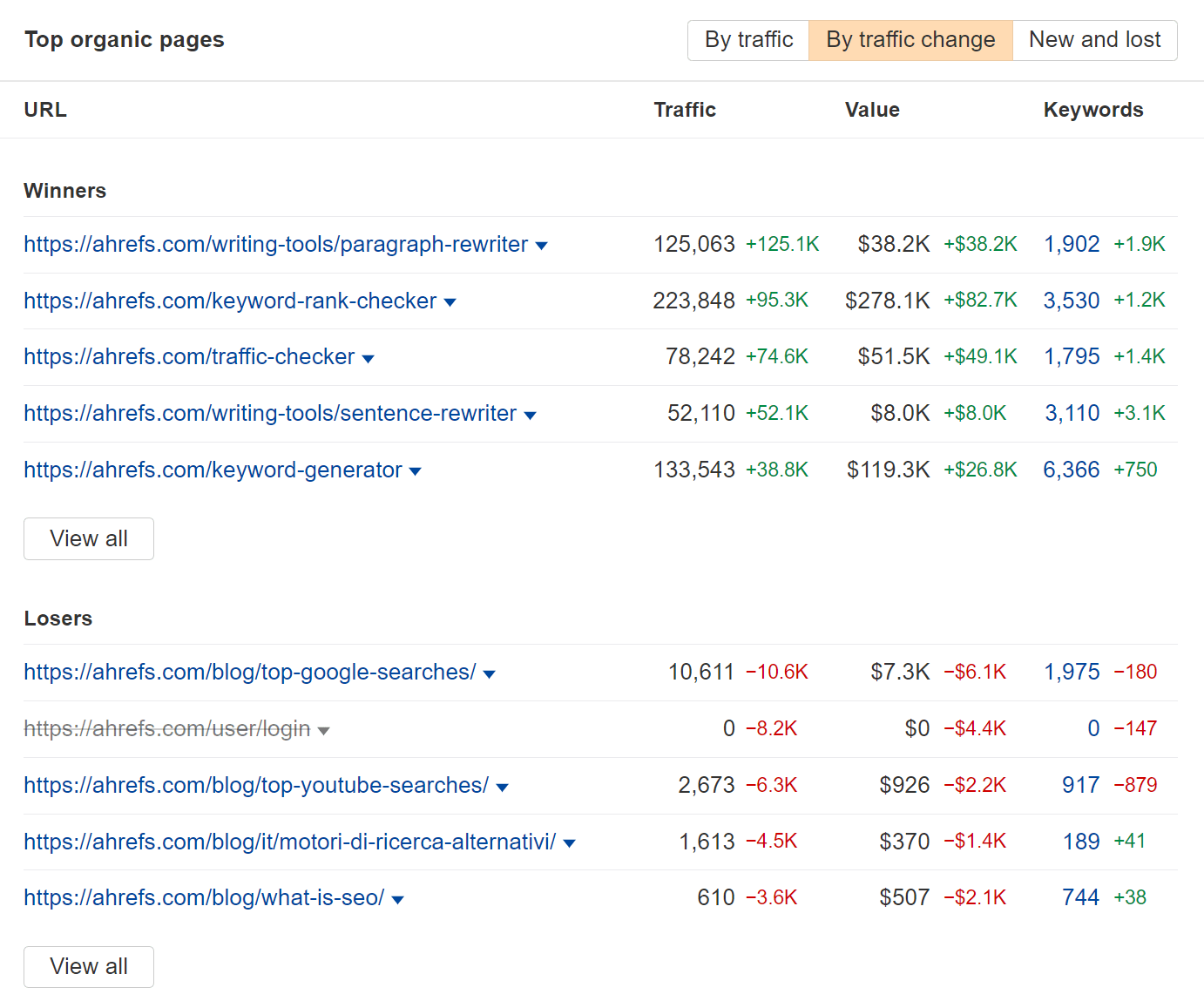
New & lost for pages and keywords
As an enterprise SEO, you can’t be everywhere at once or have visibility on every project happening on the site. You can use the new and lost reports for keywords and pages to help monitor what is changing on the site. Again, this is available on the Dashboard or you can filter for them in the individual reports like Organic Keywords or Top Pages.
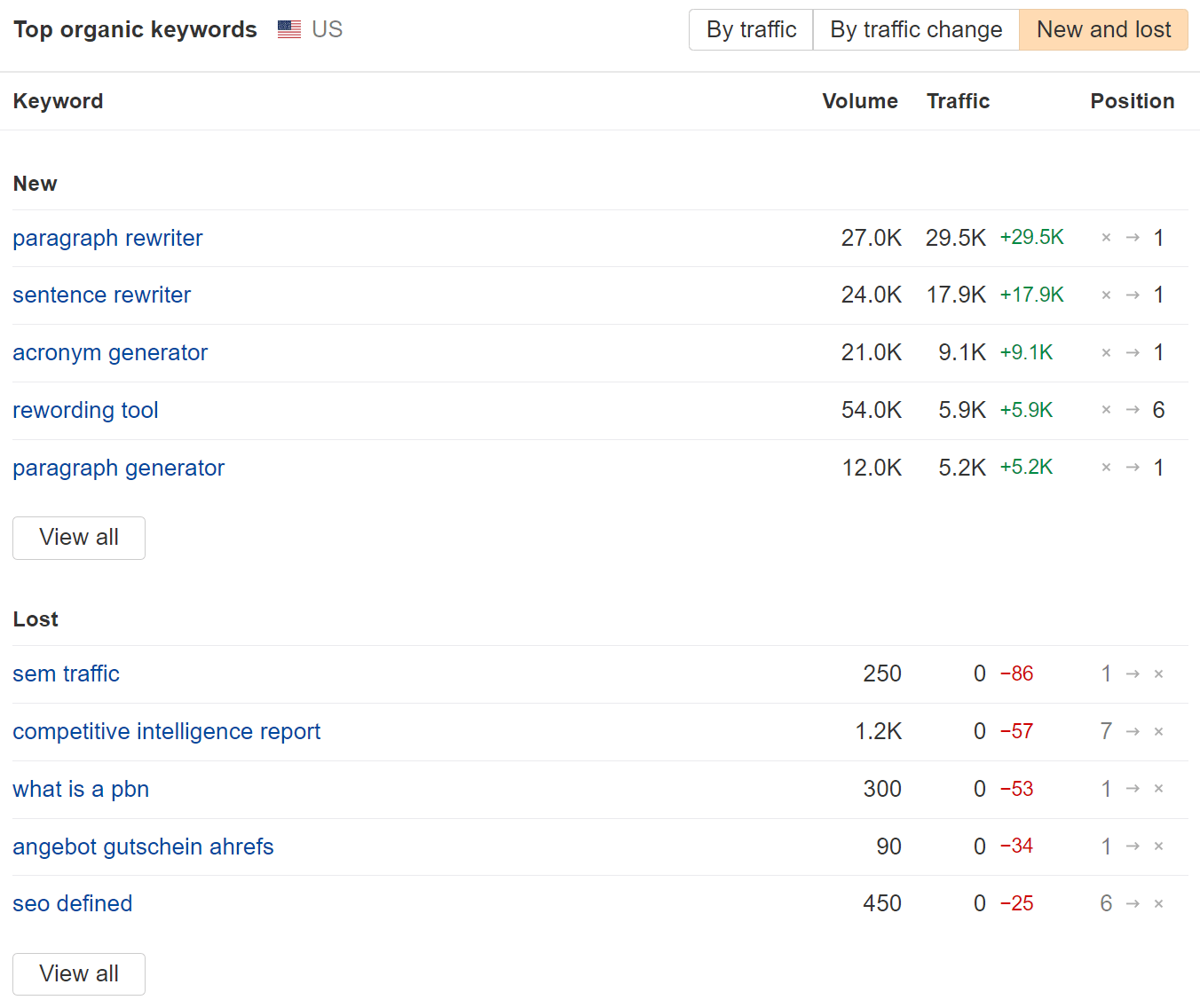
Content performance
If you’re running A/B tests, improving a group of pages, or want to monitor different authors or even business units or products who may have multiple sections, you can use the Portfolio feature on the Dashboard to add up to 1,000 pages or sections across 10 domains.

Many of the reports in Site Explorer will give you rolled up views of the content. Now you can easily see if your tests or improvements had an impact or create a scorecard view for different authors or parts of the business to check how each is doing.
Compare SERPs
The SERP comparison feature in Keywords Explorer lets you:
- See how the SERP for a given keyword has changed over time. Dig into the winners and losers in detail to figure out what Google likes or dislikes. This is especially useful when analyzing Google algorithm updates.
- Compare the SERPs for two relevant keywords to see how much overlap there is and if you can target both keywords with the same one page, or if you should create a dedicated page for each of the keywords.

Hreflang cluster visualization
We have a first-if-its-kind hreflang cluster visualization. It shows and tells you what is broken, making it much easier to explain to stakeholders than the typical spreadsheet.

User management
We have everything from single sign-on (SSO), to two-factor authentication (2FA), user controls, audit logs, and more.
Also check out our API & Looker Studio reports and the new Report Builder
In most of our reports, we have an API button that will let you pull the data needed from the reports to re-create the visuals we have or any custom ones you want to create in your own reporting platform. We tried to make this as easy as possible for everyone. You can also check our API documentation for any custom data pulls you might want to make and our guide to enterprise SEO metrics, reporting, and dashboards has lots of ideas for things you might want to include in your reports.
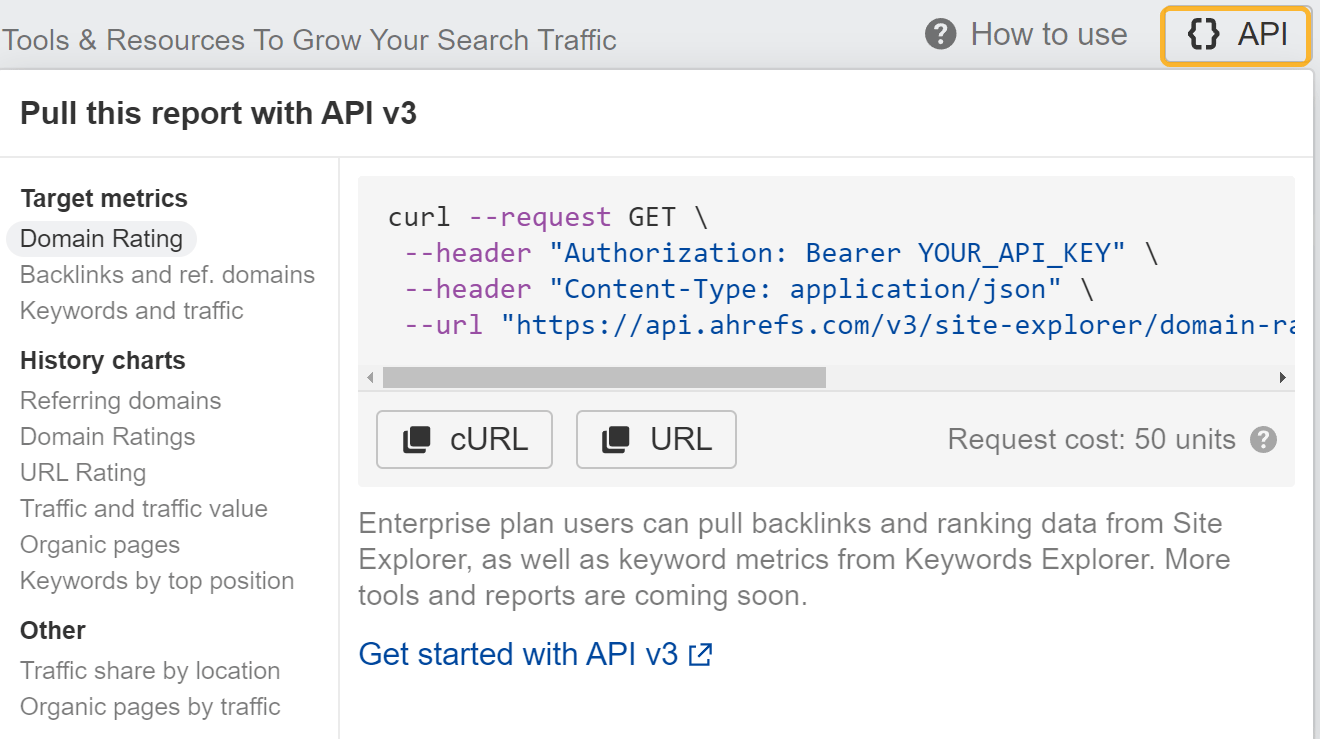
We also have Looker Studio templates you can use to create your reports. These are customizable and well documented.

Website Organic Search Traffic - 88.4K
Website Organic Traffic Value - $89K
Backlinks - 66.6K
Referring Domains - 7.5K
 How Conductor describes themselves:
How Conductor describes themselves:We are a platform and a partner for customer-first marketing.
Conductor is a technology company with a passion for helping you help your customers. Marketers use our software and services to create and optimize valuable content so that it gets found, answers questions, and solves problems for real people.
Conductor is on a buying spree. They’ve acquired ContentKing to boost their technical SEO capabilities and they also had good content around technical SEO. I’m actually featured in a lot of that content and I helped with the reviews on much of it. They also acquired Searchmetrics, which was another enterprise platform. It looks like both of their websites are redirected now.
Conductor has had a wild ride with funding, acquisitions, buying themselves back, more funding, acquiring other companies, etc.
Unique Selling Proposition of Content King: Constant Crawling and alerting
Conductor features:
- Researching keywords and competitors
- Content creation
- Optimizing site health
- Tracking keyword rankings
- Measuring performance and sharing
Pros of Conductor according to Reddit users:
- It has a clean interface
- It’s easy to do bulk updates for pairs of keywords and preferred landing pages
Cons of Conductor according to Reddit users:
- Expensive for what you get
Conductor doesn’t seem to give a number for the customers on the website, but it looks like they mentioned 450 as the number when raising funds in 2021. These include:
- LG
- Zoom
- Audible
- Microsoft
- Epic Games
- Siemens
- PNC
- Kroger
- Wyndham
- Gannett
See the Conductor product tour.
Website Organic Search Traffic - 41.7K
Website Organic Traffic Value - $53.6K
Brand searches - 1.1K
Backlinks - 28.7K
Referring Domains - 3.4K

How seoClarity describes themselves:
Providing the Best [Search] Experience in Enterprise SEO
We are all about the experience around here—for our clients and our team. Together, we work hard to drive success, tackle challenges, and grow our business.
That’s why, as an AI-driven organic search and content optimization platform, we focus on the user search experience for enterprise brands. Our approach centers on the person conducting the search - not search engine algorithms.
Our approach in building a platform and supporting our clients is what sets us apart from other solutions.
seoClarity features:
- Ranking Analysis
- Keyword Research
- Content Marketing
- Technical SEO Analysis
- SEO Analytics + Reporting
- SEO Execution
Pros of seoClarity according to Reddit users:
- Centralized features from multiple tools
- A helpful customer service team
- The Rank Intelligence feature for tracking and analyzing rankings
Cons of seoClarity according to Reddit users:
- A learning curve
- Intimidating data for some users
- A UI that’s not as flashy as other tools
seoClarity has 3500+ brand and enterprise subscribers including:
- Orbitz
- Samsung
- Autotrader
- Expedia
- Overstock.com
Watch the seoClarity demo.
Website Organic Search Traffic - 14K
Website Organic Traffic Value - $13.8K
Brand Searches - 8.6K
Backlinks - 9.8K
Referring Domains - 2.1K

What Botify says about themselves:
Founded in 2012, Botify built the interface and methodology that connects the largest, most complex sites with all the major search engines to drive more traffic and revenue from organic search.
Our full-funnel methodology and unified data model ensures that we have the broadest view of your website, while our machine-learning algorithm prescribes the actions that will drive the greatest impact and automates time-consuming SEO processes.
I’m not sure I’d ever personally use Botify. I hear great things from other technical SEOs, but I had a bad personal experience with their sales team. Worth checking out, but you may end up having to block them in multiple places like I did.
Unique Selling Proposition of Botify: they’re all in on technical SEO.
Botify features:
- SEO auditing and monitoring
- SEO reporting
- Log file analysis
Pros of Botify according to Reddit users:
- Technical SEO
- Log File Analysis
Cons of Botify according to Reddit users:
- Expensive
- Aggressive sales team
Botify has over 500 customers including:
- The New York Times
- Macy’s
- Farfetch
- Levi’s
- Clarins
- Expedia
- Marks & Spencer
- Crate & Barrel
- L’Oréal
- Fnac Darty
Website Organic Search Traffic - 63.7K
Website Organic Traffic Value - $116K
Brand Searches - 11K
Backlinks - 53K
Referring Domains - 10.6K

What BrightEdge says about themselves:
BrightEdge is an enterprise SEO marketing company that transforms online content into tangible business results, like traffic, engagement, and revenue. BrightEdge’s SEO platform is powered by a sophisticated AI and machine learning engine. Because it crawls the web and collects first-party data, it is the only enterprise SEO company capable of web-wide, real-time measurement of digital content engagement across all digital channels, including search, social, and mobile.
Last year marketers spent over $135 billion creating digital marketing content, however, this content has limited value unless it’s found and connected to ROI. With BrightEdge Content Performance Marketing, brands for the first time can predictably plan, optimize, and measure campaigns based on actual content performance.
BrightEdge acquired Oncrawl which should help them be better for technical SEO, because their old ContentIQ system was not the best in my opinion. I haven’t used them in years, but I’ll say when I did it was a bit frustrating. The platform was slow and the insights provided we pretty meh. They might help someone very new to SEO, but they’ll also have you do a lot of things that waste time because they have no impact.
I also had some issues with Data Cube that may still exist, but I can’t confirm if they do or not. I used to put in relevant terms like “ai” and I would get irrelevant results back like “gmail”. You also had to be careful not to inflate the opportunities because multiple terms that were plurals or misspellings would show with the same volume as the main term.
BrightEdge created some SEO industry drama over patent trolling another company, Searchmetrics, about a decade ago.
BrightEdge features:
- Customizable Dashboards, Reporting, & Forecasting
- Content Performance Recommendations
- Backlink Management
- Content Centric Marketing
- Social Content Performance
- Local, Global, and Mobile Content Performance
- Competitive Analysis
- Universal Search
- Integrations
- Project Management
Pros of BrightEdge according to Reddit users:
- Dedicated account reps
- Good user support
Cons of BrightEdge according to Reddit users:
- High price
- Difficult setup
- Difficult to organize keyword tracking
- Most companies only use it for rank tracking
- Overpromises on capabilities
BrightEdge has over 1700 customers including:
- L’Oréal
- Adobe
- UC Davis
- Workday
- Twilio
- Cleveland Clinic
- Microsoft
- Marriott
Make sure you choose the right enterprise SEO tool
Onboarding an enterprise SEO tool can be a long and difficult process. Getting rid of a bad tool once it’s integrated into your systems can be even harder. Make sure you do your homework and select the right solution for you.
As we’ve built out our enterprise offering, we’ve added a lot of features that enterprise companies need to be successful and all the pieces they need to meet compliance guidelines. If you have a feature you want to see us add, message me on Twitter.



